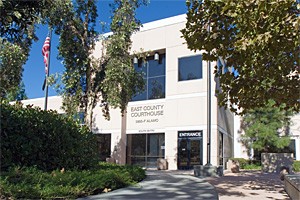The Superior Court of California: County of Ventura
Introduction
Text-to-speech Audio
This first entry related to the 1992 LA Riots is distant from most of the other locations. However, the Superior Court of California in Ventura County played a significant role in the L.A. Uprising of 1992. Here, the jury acquitted the four police officers charged with assaulting Rodney King in 1991. Immediately after the acquittal, the protests quickly began, effectively starting the riots.
Images

Backstory and Context
Text-to-speech Audio
On March 3, 1991, Rodney King was violently assaulted by four police officers. Twenty-five at the time, King was stopped for speeding on a highway in San Fernando Valley. However, instead of simply handing him a ticket or letting him off with a warning, the officers “stopped [King with] a stun gun, and repeatedly kicked and beat” him (Abelmann and Lie). Unlike many past cases of police brutality, the excessive force and violence was videotaped; George Holliday recorded the entire beating from his apartment balcony. Though Holliday called the Los Angeles Police Department (LAPD), King did not receive any assistance. Instead, twelve other officers watched the beating take place. Thus, Holliday decided to call a local news station which later broadcasted his footage.
The four police officers who directly attacked King stood trial on April 29, 1992 at the County of Ventura Superior Court. Here, “twelve Simi valley jurors—ten European Americans, one Latino, and one Asian American—acquitted all four officers” (Abelmann and Lie). Despite the video evidence and widespread broadcast of King’s assault, the police officers did not have to take accountability for their racist behavior. While this cycle of police brutality and acquittance often repeated itself in the past, the Black community hoped that finally with the video proof and media attention, King’s story would end differently. Unfortunately, they were wrong, and “such consistently unfair verdicts...promoted...that Black people have no rights that white people are bound to respect” (Madhubuti). In addition, there was another recent case that acquitted a Korean woman for murdering a teenage African American girl named Latasha Harlins. Thus, King’s story, combined with Latasha’s and all the built up racial tension, served to push the Black community to riot against the racism and injustice in Los Angeles.
The results of the case quickly spread. Almost immediately after the judge delivered the verdict, a crowd gathered outside the courthouse to protest the results, beginning the 1992 Los Angeles Uprising. While the riots quickly grew violent and destructive, “in their origins, the riots were...for Rodney King...they were for Latasha Harlins” (Abelmann and Lie). Black protestors wanted to stand up against the oppression and fear they experienced on a daily basis.
Sources
Abelmann, Nancy, and John Lie. Blue Dreams: Korean Americans And the Los Angeles Riots. Cambridge, Mass.: Harvard University Press, 1995.
Abelmann and Lie offered a deep dive into how the 1992 L.A. Uprising affected the Korean American community. They account and examine issues which previously existed and engendered Black resentment against Korean Americans. Additionally, they also describe the experiences of Korean Americans during the riots and in the aftermath as Los Angeles struggles to rebuild.
Bates, Karen Grisby and Anjuli Sastry. “When LA Erupted In Anger: A Look Back at the Rodney King Riots.” NPR. NPR, 26 Apr. 2017, www.npr.org/2017/04/26/524744989/when-la-erupted-in-anger-a-look-back-at-the-rodney-king-riots.
The article by Bates and Sastry gives a detailed account of what happened during the riot and how the uprising affected several different areas of South Los Angeles.
Cannon, Lou. Official Negligence: How Rodney King And the Riots Changed Los Angeles And the LAPD. New York: Times Books, 1997.
Lou’s analysis of the 1992 Los Angeles Uprising provides a great deal of information spanning the entire timeline of the rioting, from Rodney King’s beating to the impacts the rioting had on the political environment and police department. With many direct quotes, Lou goes step by step through the riot and examines the entire event unfolding.
Madhubuti, Haki R., 1942-. Why L.A. Happened: Implications of the '92 Los Angeles Rebellion. Chicago: Third World Press, 1993.
Madhubuti compiles a series of essays from several authors which discuss the factors that caused the Los Angeles rioting.
Mydans, Seth. “Riots In Los Angeles: Pocket of Tension; A Target of Rioters, Koreatown is Bitter, Armed, and Determined.” The New York Times Company. The New York Times, 2 May, 1992, https://www.nytimes.com/1992/05/03/us/riot-los-angles-pocket-tension-target-rioters-koreatown-bitter-armed-determined.html.
Mydans’ article accounts the personal responses of Korean Americans to the rioting of Koreatown.
The Associated Press. “Rodney King Riot: Timeline of Key Events.” AP NEWS, Associated Press, 26 Apr. 2017, apnews.com/article/fa4d04d8281443fc8db0e27d6be52081.
The Associated Press provides a concise timeline of events outlining the uprising.
